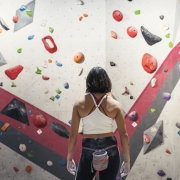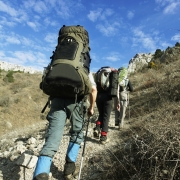What do we know?
In our current COVID world, there has been a concerning sharp spike of ground falls in UK climbing centres post lockdown one.
In one seven-day period, in the latter part of 2020, we had reports of the equivalent number of these incidences that we would usually expect in a ‘normal’ year.
After extensive discussions, the authors of this piece decided that scrutiny of these Incidents and Accidents was prudent to learn lessons for the future. The authors looked at the wearing of masks in climbing centres, and the accident data respectively.
About the Authors: Joby Maw Davis is a Full AMI member and holds the Winter Mountaineering and Climbing Instructor qualification. He is a Technical advisor for a lot of the major climbing walls in the UK. He is also a Technical expert for NICAS and the Association of British Climbing Walls as well as a provider for many of the Mountain Training National Governing Body awards.
Libby Peter is a Full Mountain Guide and a Member of the British Mountain Guides. Between them their technical knowledge of rock climbing both indoors and outdoors is unsurpassed 😊. Neither of them “work” (i.e. are paid) by AMI. This article and research was done independent of AMI but AMI both support it and back it.
Possible explanations could be:
- Climbers who have taken a break from climbing may have rusty skills (Skills fade posh term)
- The past year has been rough; we can all agree on that. More people may be mentally and emotionally exhausted than an average year.
- People are excited to return to their hobbies, but are they prepared?
Observations:
- All the noted accidents and incidents involved lead climbing (belaying).
- They all resulted in ground falls of varying seriousness.
- Climbers and belayers involved were not novices and had climbed at the centre they were in at the time of the occurrence numerous times since the end of lockdown one.
- Accidents and incidents occurred generally in the first half of the route attempted.
What are the variables that have the potential to cause climbers / belayers issues?
Skills fade – quick confidence gains… then complacency. These incidents have not involved novices.
Amplification of previously ‘just off’ good practice. For example, poor belayer positioning and slack management; this is especially important while the climber is around 2nd-4th clips as lead falls from here require very quick reactions by the belayer to prevent a ground fall. There is a likelihood, if climbers and belayers were operating in a slightly sloppy fashion pre COVID (unconscious incompetence or conscious incompetence), that their skills will have slid somewhat.
Face mask issues
Even the neatest fitting facemask restricts lower peripheral vision. In other words, it is harder to see the ground just in-front of your feet. This leads to more frequent trips and falls (mostly in the elderly), but it also makes it harder to glance down and see what’s going on at your belay device, creating a number of potential problems:
1. Blocks the view of how much slack is out immediately in-front of the belay device. It’s possible to have a loop of slack out (i.e. too much slack) and not realise.
2. Less confidence in making quick adjustments to the amount of slack out (slack management). Some belayers need to look down at the belay device when paying out or taking in.
3. Can’t see trip hazards around feet (such as rope) so might result in the belayer moving around less to adjust slack, or an actual trip.
Poor fitting masks
4. Habitual readjustment of mask as it slips down over nose – means two hands not on the rope.
Belay glasses and masks
5. This combination definitely further limits lower peripheral vision leaving only a slim letter box view.
6. Moving belay glasses into place as leader reaches second or third clip could be even slower with mask on – and may knock the mask out of place leading to point 4 above.
Prescription glasses and masks
Glasses steaming up is a big issue for belayers and leads to a few scenarios, all of which have their own potential impact on effective belaying:
7. Leave steamed up glasses in place and have trouble seeing clearly enough to detect climber movements that might suggest an imminent fall, or to preempt clipping.
8. Take glasses off and, depending on quality of vision without glasses, have trouble seeing as above.
9. Alternate between glasses on and off resulting in two hands not on the rope.
10. Leave glasses on and pull mask down to prevent fogging – and reduce Covid safety.
Some real-life suggestions to help makes your first steps ‘back’, as safe as possible for your and your partner.
Climbers
Why not treat the first session back as a refresher of all belaying elements?
Take things more slowly than you would do ‘normally’. How about a top-rope before leading if haven’t climbed in a mask on for example?
Make no assumptions about belaying/climbing skills for you and you partners / s
Never forget the lifesaving PARTNER CHECK
Belay device/rope compatibility check, have you purchased new equipment?
Be extra vigilant; remember other’s actions could also impact on you and your partner’s safety.
Communication – revisit with your partner your communication routine, it may well have been some time since you climbed together!
Instructors and coaches
Expect to give more support than normal to your climbers and belayers, remember the operational changes in your sessions will be well drilled for you, but they will be new to your climbers.
Mask education – help clients to develop a mask system that is Covid safe and climb safe.
Have extra vigilance when backing up belaying, it is probably the case that in your centre / organisation you are dealing with this in a more socially distanced fashion.
Be prepared and equipped to intervene quickly if deemed necessary. Have these drills been well practiced amongst staff?
Frame of Reference
Minor Interactions :- Behaviours and or actions that can contribute to the increased chances of any of the above
Near Miss:- An event not causing harm, but has the potential to cause injury or ill health
Incident:- a set of conditions or circumstances that have the potential to cause injury or ill health and could result in damage to equipment and facilities.
Accident:- An event that results in injury or ill health
Many thanks to the authors Joby Maw Davis (AMI) Climbing and Mountain Training http://www.jobymawdavis.co.uk/and Libby Peter (IFMGA Guide)



